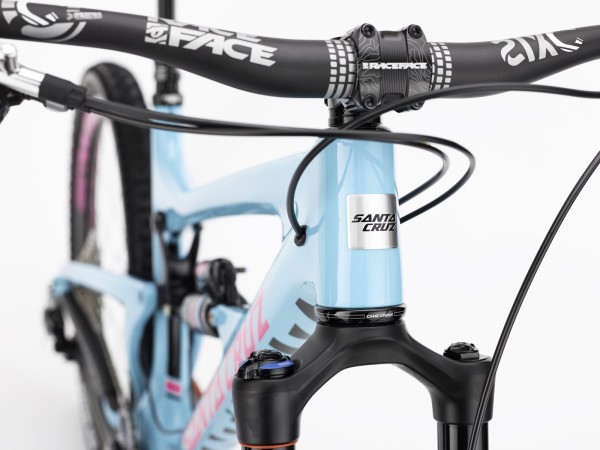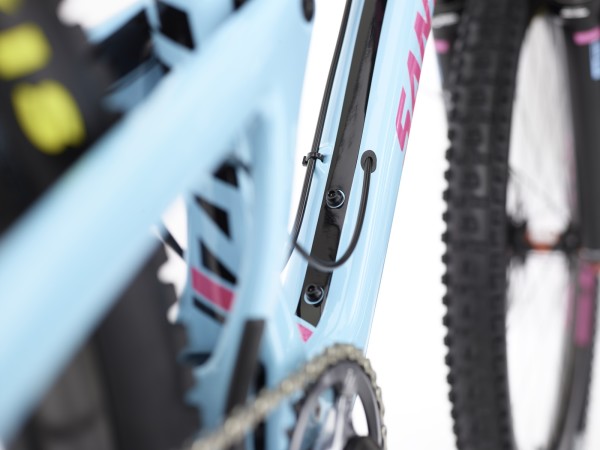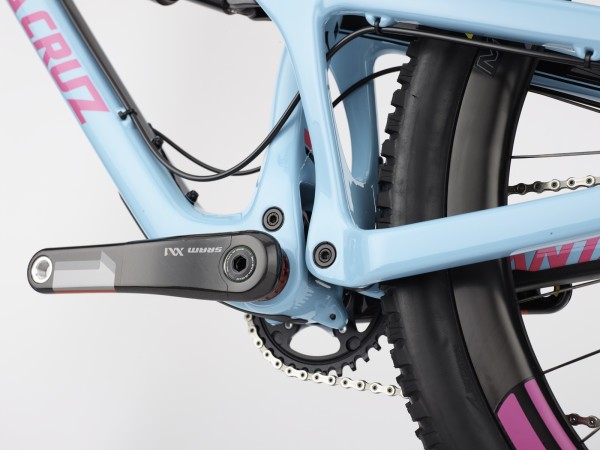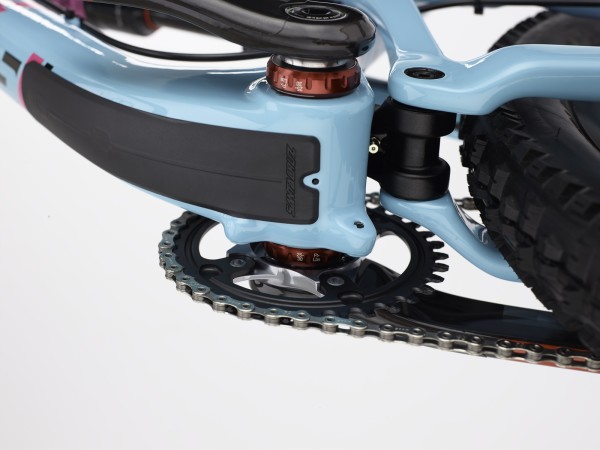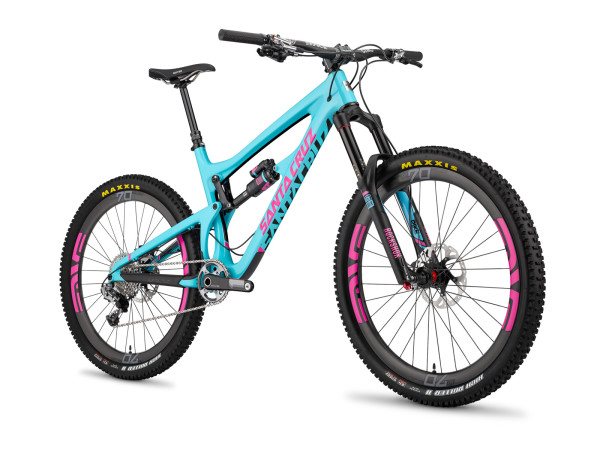 On this date last year, Santa Cruz Bikes launched the Bronson, an all new platform designed entirely around the new wheel size. In that intervening period, the company has launched so many new 650 bikes, updated models, and new brands, that we’ve sort of lost track.
On this date last year, Santa Cruz Bikes launched the Bronson, an all new platform designed entirely around the new wheel size. In that intervening period, the company has launched so many new 650 bikes, updated models, and new brands, that we’ve sort of lost track.
Product launch after product launch we kept our fingers crossed, and now after a long year of waiting, the new Nomad is here. Completely redesigned from the ground up, the new bike promises to look pretty in pink and still offer syndicate world cup stability. Huck past the break to learn all about it…
UPDATED: Q&A with Joe Graney about the new design and overall changes added at bottom of post!
The new SC badge replaces the old S-Man Headtube Badge
One of the last hold outs to internal routing, Santa Cruz has finally caved. This is the first model they’ve ever offered (in our recollection) with internal routing. The new Nomad is a 65º headtube angle, single ring, 165mm travel, trail slaying machine.
Over the years, the company has developed a reputation in the service department for being easy to work on, and this new model is no exception to the rule. While some companies have yet to figure out how to do internal routing well, Santa Cruz has made future cable swaps a breeze by molding carbon fiber tubes into each frame from entry to exit. Hurrah!
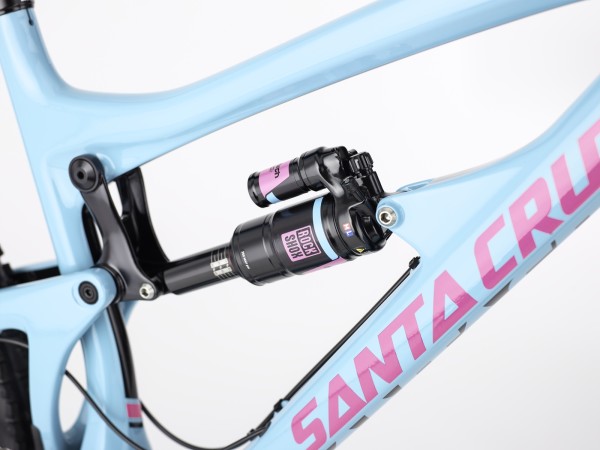
Travel has been increased to 165mm in the rear and a V10 style upper link has been added, to improve small bump performance.
The Monarch Plus Debonair (a shock not currently listed on the Rockshox website) will be spec’d on stock frames, but an upgrade to a Vivid Air is available for an additional $251.
A steeper seat tube angle has been added to to keep riders better balanced over the bike when grinding uphill.
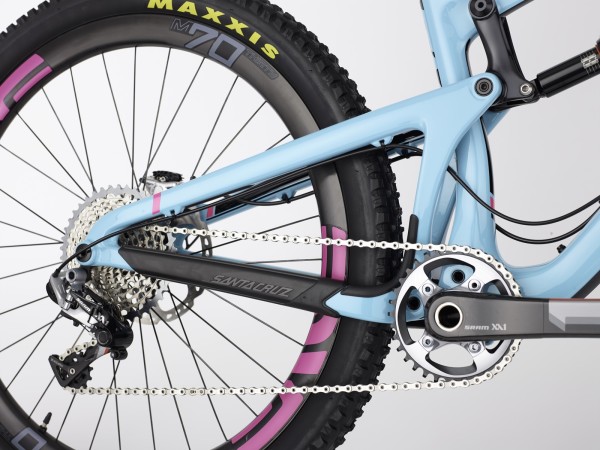
Up front, you’ll notice they’ve broken free from the front derailleur…
…which has enabled the engineers to tuck in the lower link and shrink the chainstays by .2″ to 17.1″.
On the older Nomad and all of the additional VPP models currently offered by Santa Cruz, the lower link protrudes below the BB, and it was not uncommon for owners to complain of rock strikes and paint chips. The new design makes the link less vulnerable, but still houses a grease port and beefy hardware.
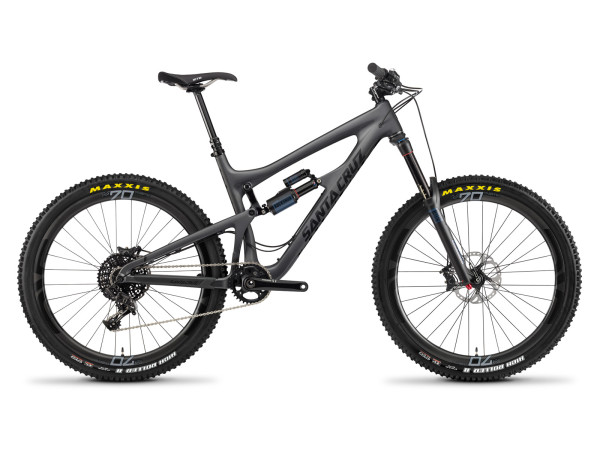
In addition to the tinkled pink and Bahama blue frame, the Nomad will be available in a black on stealth bomber black paint scheme. Both models will come with color coordinated fork, shock, and wheel decals.
Sharp eyed readers will also notice the Enve Wheels sporting a special “70” badge next to the normal decals. We’re under embargo until April 8th, but you can let your guesses rip in the comments section.
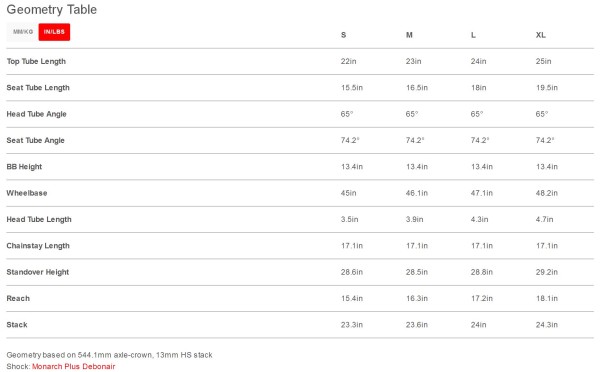
As part of the redesign, the Nomad has grown an inch in the cockpit…for your pleasure.
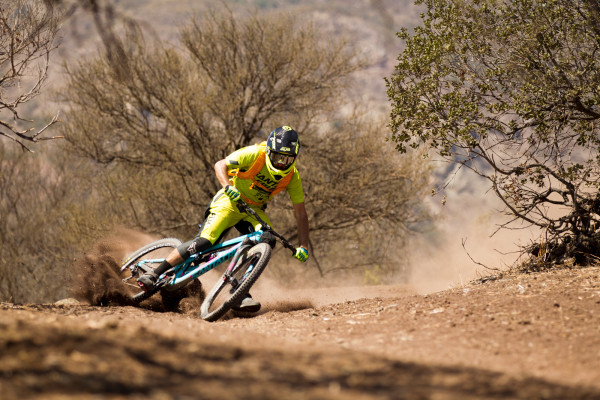
FEATURES
- 165mm VPP suspension
- 27.5” wheels
- Internal routing
- New compact lower link and V10-style upper link
- Full carbon frame and swingarm in S, M, L & XL sizes
- Single-chain-ring-only design
- RockShox Pike RCT3 Solo Air160mm fork
- RockShox Monarch Plus Debonair or Vivid Air RC2 shock
- USA pricing from $6,599 complete for SRAM X01 build, inc. Reverb Stealth (Updated 4/1)
- $2,999 frame only
- Frame weight from 6.2 lbs (2.8 kg) with Rock Shox Monarch Plus
- Complete from 27.1 lbs (12.3kg)
DETAILS
- Internal routing made from molded carbon tubes: ensures precise and hassle free feeding of rear derailleur and seat post cables.
- 31.6” seat tube: accommodates 150mm Reverb Stealth seat posts.
- Bottle cage mounts within front triangle: works with piggyback shock.
- Molded rubber swingarm and downtube protectors.
- Forged aluminum upper link and lower link.
- Single recessed grease port on lower link: feeds all for four bearings.
- Collet axle pivots: lock in place without pinch bolts.
- Angular contact bearings on collet pivot axles.
- Full carbon dropouts and disk mounts.
- Co-molded aluminum hardware on frame pivots.
- Carbon ISCG-05 tabs.
- 142 mm rear axle spacing.
- Threaded BB: creak-free riding and easy installation.
- 5 year warranty with lifetime bearings and crash replacement warranty.
We’re headed to the Santa Cruz Factory later today (after some shut eye) and will be posting more details, so please stay tuned.
Q&A WITH JOE GRANEY
BIKERUMOR: Why the change to the lower links forward pivot point? As in, how does this change performance?
JOE: Two significant reasons: Lowering the BB height lowers the BB pivot and lower link. Our goal was to protect the pivot and link from rock strike damage. Secondly, it’s the way to shorten the chainstay length of the bike by moving the BB pivot forward. The link length is similar to other VPP bikes, but its just tucked up and hidden from view. Also, see next answer…
BIKERUMOR: What were the goals when redesigning the VPP suspension?
JOE: There isn’t a real “resdesign” of VPP, more of an adaptation. The goals of this adaptation to this model: Maintain our great pedaling performance, while making small bump performance better, giving better mid-stroke support, and working well with the next generation of downhill oriented air shocks. The travel difference between the Nomad and Bronson (165mm vs 150mm) seems small, but there are distinct differences you’ll understand when you ride both.
BIKERUMOR: With the lower link’s forward pivot now above the BB, it’s looking closer to a DW-link design. What are the key axle path and performance differences between this new design and, say, a Pivot Mach 6?
JOE: The two links on all VPP bikes rotate in counter-clockwise directions, a patented attribute of our suspension technology. Any aesthetic similarities to other suspension systems are not a factor in our design process.
BIKERUMOR: What makes this bike 1x specific? Just the lack of a front derailleur mount, or something else? Why make it 1x only?
JOE: We spent several months on this particular issue. We had mules using lower link driven shocks for different shock rate characteristics, as well as upper link driven mules, and ones tailored to suit coil shocks. We were testing mules as early when the Syndicate were testing with Fox suspension in Italy in January 2012 (there were some “spy shots” of my mule during those tests). Yeah, we took awhile to figure out the rest….
The 1x wasn’t a goal, we tried to make all the of pieces fit, but with the advent of expanded gearing with a 1X system, it no longer felt like a compromise to do that. We continue to use a threaded BB and ISCG05 tabs, which enables users of varied drive trains to fit components fitting a bike for this use.
BIKERUMOR: Are these design changes specific to this bike’s intended use, or will they carry over to the rest of the line?
JOE: We design every bike to fit its intended use. The VPP counter-rotating link configuration is very adaptable, offering varying shock mounting locations, and its ability to tailor shock rates and pedaling behavior to applications from XC to DH. We’d never copy the “look” of pivot placement to another platform for aesthetic purposes.
BIKERUMOR: Why did you do internal routing, which you have eschewed like new standards like pressfit, the plague, and so forth?
JOE: Because it solved a problem. Stealth routing is de facto internal routing, so we extended it to the rear derailleur (RD). The RD cable enters the left side of the DT, and exits the right side. The routing “tubes” for the RD and post are molded in carbon during the one-piece molding process. Its a structural piece of the frame, not a glued in tube. You just push the housing in one end and it comes out the other end (or up the seatube for the post). No rattling of housing, no hassle. Its easier than zip ties actually. The RD cable never rubs the paint on headtube either. Makes it easy to travel with your race bike and to remove the Stealth Reverb quick disconnect as well.
This is a little tweaky, but we spent a (boat)load of time perfecting it. When you use it, you’ll get it. Please don’t just bill it as “internal routing”. Mostly that means a f**king user headache, which we didn’t want to perpetuate.
BIKERUMOR: Thanks Joe!
Photo Creds: Studio images © Santa Cruz Bicycles. Action images © Gary Perkin / Santa Cruz Bicycles.
